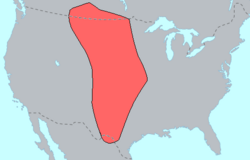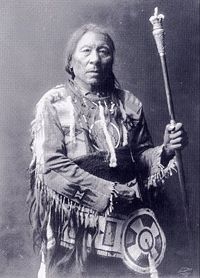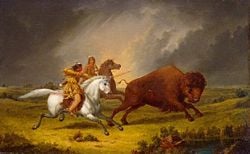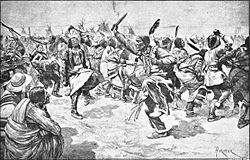Plains Indians
The Plains Indians are the Indians who lived on the plains and rolling hills of the Great Plains of North America. Their greatest dominance lasted from approximately 1750 to 1890.
Classification
Plains Indians are usually divided into two broad classifications which overlap to some degree.
The first group were fully nomadic, following the vast herds of bison. They are said to have been part of the Buffalo Culture (sometimes called somewhat misleadingly, the Great Plains Culture). Some tribes occasionally engaged in agriculture—growing tobacco and corn primarily. These included the Blackfoot, Arapaho, Assiniboine, Cheyenne, Comanche, Crow, Gros Ventre, Kiowa, Lakota, Lipan, Plains Apache (or Kiowa Apache), Plains Cree, Sarsi, Shoshone, and Tonkawa.
The second group of Plains Indians (sometimes referred to as Prairie Indians), the semi-sedentary tribes, in addition to hunting bison, lived in villages and raised crops. These included the Arikara, Ioway, Kaw (or Kansa), Mandan, Omaha, Osage, Otoe, Pawnee, Ponca, and Wichita.
The tribes of the Great Plains have been found to be the tallest people in the world during the late 1800s, based on 21st century analysis of data collected by Franz Boas for the World Columbian Exposition.[1] This information is significant to anthropometric historians, who usually equate the height of populations with their overall health and standard of living.
Culture
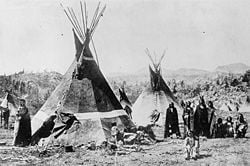
The nomadic tribes survived on hunting, and the bison was their main food source. American buffalo, or simply buffalo, is the commonly used (but inaccurate) name for the American Bison. These animals were the largest source of items such as food, decorations, and crafting tools; not a single part of the animal was thrown away.
The tribes kept moving following the migration of the bison. The Plains Indians lived in tipis because they are easily disassembled and so allow a lifestyle of following game. The Plains tribes adopted a horse culture beginning in the 17th century when escaped Spanish horses were obtained.
Hunting in the Plains
Although they hunted other animals, like elk or antelope, bison was by far the most plentiful food source throughout their area. Before horses were introduced, hunting was a complicated process. The Native Americans would surround the bison, and then they would try to herd them off of cliffs or into places where they would be more easily killed. A commonly used technique was the Piskin method. The tribesmen would build a corral and have people to herd the buffalo into it where they could be killed. This would be achieved by constructing a v-shaped funnel, about a mile long, constructed of fallen tree, rocks etc.. The buffalo would be lured into the trap with one of the tribe dressing up in a buffalo skin and imitating the call of a buffalo.
The weapons of the Plains Indians were spears, bows and various forms of club. When horses were introduced to the Indians when white settlers came to America, it made hunting much easier. With horses, the Indians could simply stampede and overtake the bison with their speed, and many bison were slaughtered at point-blank range from horseback. The bows were then changed in design, reduced to only three feet in length, to make them easier to shoot from horseback. Bows were still used when guns were introduced, as guns took too long to reload and were too heavy. In the summer, many tribes would gather in one place to hunt. The main hunting seasons were fall, summer, and spring, as in winter, harsh snow and mighty blizzards made it almost impossible to kill the bison.
Over years of surviving off the hunt, Plains Indians developed an ability to survive longer off of less food through metabolism. In long intervals between hunts, Native Americans survived by this adaptation. And in times of plentiful food, Plains Indians took on a lot of extra weight to prepare for a time without food. This adaptation saved tribes from starvation in their old way, but when reservations were introduced the adaptation became a threat. Because they were confined to reservations, Natives were generally no longer able to hunt for food, so they took up other means of subsistence.
Great Plains religion
The Plains Indians followed no single religion. Animist religion was an important part of a Great Plains Indians' life, as they believed that all things possessed spirits. Their worship was centered on one main god, in the Sioux language Wakan Tanka (the Great Spirit). The Great Spirit had power over everything that had ever existed, and the Indians believed that by worshipping him they would become stronger. Earth was also quite important, as she was the mother of all spirits. Spirits were worshipped daily. People sometimes prayed alone, while other times there were group gatherings. The most important group ceremony was the Sun Dance. In the Sun Dance, participants danced for four days around a sacred object, and some would inflict harm upon themselves on purpose, all while staring at the sun. They believed this self-sacrifice would encourage powerful spirits to support and defend them.
There were also people that were wakan, or blessed, who were also called shaman. To become wakan, your prayers must be answered by The Great Spirit, or you must see a sign from him. Wakan were thought to possess great power, and one of their jobs was to heal people, which is why they are also sometimes called the medicine man. They healed by trying to convince a person that they weren’t sick, or they used drugs, like an old-day version of aspirin and skunk-cabbage to cure asthma. The shamans were considered so important that they decided when to hunt. Plains Indians also thought that some objects possessed spiritual power. One such item was the medicine bundle, which was a sack that carried items that were thought to be important to the owner. Items in the sack might include rocks, feathers, and more. Another thing that was very spiritual was the shield. The shield was the most prized possession of any warrior, and he decorated it with many paintings and feathers. The animals that were drawn onto the shield were thought to protect the owner.
ReferencesISBN links support NWE through referral fees
- ↑ "Standing Tall: Plains Indians Enjoyed Height, Health Advantage", Jeff Grabmeier, Ohio State
- "American Indian Contributions To Science and Technology", Chris R. Landon, Portland Public Schools, 1993
- "Buffalo and the Plains Indians", South Dakota State Historical Society Education Kit
Bibliography
- Carlson, Paul H. The Plains Indians. College Station: Texas A&M University Press, 1998. ISBN 0-89096-828-4
- Taylor, Colin E. The Plains Indians: A Cultural and Historical View of the North American Plains Tribes of the Pre-Reservation Period. New York: Crescent Books, 1994. ISBN 0517142503
Credits
New World Encyclopedia writers and editors rewrote and completed the Wikipedia article in accordance with New World Encyclopedia standards. This article abides by terms of the Creative Commons CC-by-sa 3.0 License (CC-by-sa), which may be used and disseminated with proper attribution. Credit is due under the terms of this license that can reference both the New World Encyclopedia contributors and the selfless volunteer contributors of the Wikimedia Foundation. To cite this article click here for a list of acceptable citing formats.The history of earlier contributions by wikipedians is accessible to researchers here:
The history of this article since it was imported to New World Encyclopedia:
Note: Some restrictions may apply to use of individual images which are separately licensed.
